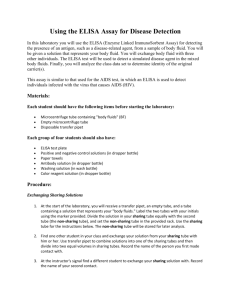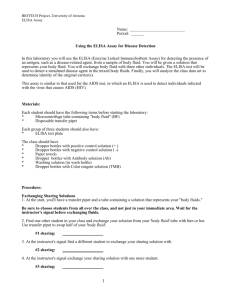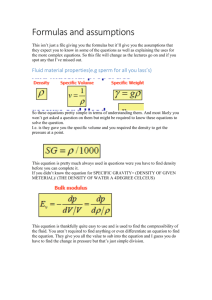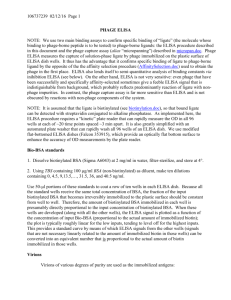ELISA Assay student handout
advertisement
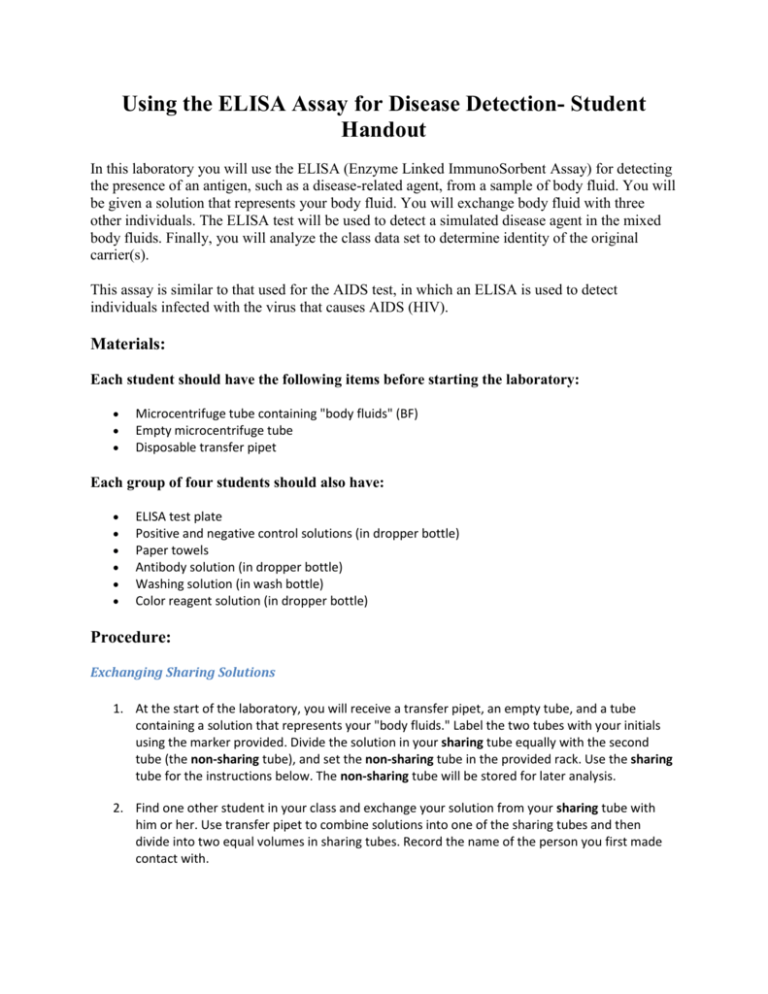
Using the ELISA Assay for Disease Detection- Student Handout In this laboratory you will use the ELISA (Enzyme Linked ImmunoSorbent Assay) for detecting the presence of an antigen, such as a disease-related agent, from a sample of body fluid. You will be given a solution that represents your body fluid. You will exchange body fluid with three other individuals. The ELISA test will be used to detect a simulated disease agent in the mixed body fluids. Finally, you will analyze the class data set to determine identity of the original carrier(s). This assay is similar to that used for the AIDS test, in which an ELISA is used to detect individuals infected with the virus that causes AIDS (HIV). Materials: Each student should have the following items before starting the laboratory: Microcentrifuge tube containing "body fluids" (BF) Empty microcentrifuge tube Disposable transfer pipet Each group of four students should also have: ELISA test plate Positive and negative control solutions (in dropper bottle) Paper towels Antibody solution (in dropper bottle) Washing solution (in wash bottle) Color reagent solution (in dropper bottle) Procedure: Exchanging Sharing Solutions 1. At the start of the laboratory, you will receive a transfer pipet, an empty tube, and a tube containing a solution that represents your "body fluids." Label the two tubes with your initials using the marker provided. Divide the solution in your sharing tube equally with the second tube (the non-sharing tube), and set the non-sharing tube in the provided rack. Use the sharing tube for the instructions below. The non-sharing tube will be stored for later analysis. 2. Find one other student in your class and exchange your solution from your sharing tube with him or her. Use transfer pipet to combine solutions into one of the sharing tubes and then divide into two equal volumes in sharing tubes. Record the name of the person you first made contact with. 3. At the instructor's signal find a different student to exchange your sharing solution with. Record the name of your second contact. Note: Be sure to choose students from all over the class, and not just in your immediate area. Wait for instructor's signal before exchanging fluids. 4. At the instructor's signal exchange your sharing solution solution with one more student and record the name of your third contact. ELISA Test 1. After all three contacts have been completed, you will do an ELISA test on your sharing tube fluid. 2. Form a group (usually three or four people) at your lab station. Your group will run an ELISA assay on your mixtures of body fluids from each student in your group using an ELISA plate. 3. Using your transfer pipet, add three (3) drops of your sharing tube fluid into each of three wells. Record which wells contain your fluid to avoid confusing your wells with another student's. 4. Each group will also do one positive and one negative control. Using the dropper in the bottle, add two (2) drops of a positive control solution into three wells and two (2) drops of a negative control solution into a different set of three wells. 5. After everyone has added their solution, leave the plate on the lab table undisturbed for five minutes. 6. Shake off the fluid into a nearby sink or designated container, making sure that the fluid has emptied from each well. Tap the plate upside down onto the paper towel to remove any excess liquid or bubbles. 7. Add washing solution to the wells as shown by your instructor, and shake off fluid. Repeat a total of three times. 8. Add two (2) drops of the antibody solution to each utilizedwell. 9. Allow five minutes incubation time on the lab table and then shake off the fluid. 10. Add washing solution to the wells as done in step 7, and repeat washing a total of three times. 11. Add two (2) drops of the color reagent solution to each well. 12. Record your observations after five minutes. 13. Each group will record the results of the tests. Be sure to record whether you are infected. You will also record your test results and list of partners on the blackboard. 14. Given the classroom data, determine the original infected carriers. After identifying potential sources of the disease, you can confirm your analysis by performing another ELISA assay on the non-shared samples. Laboratory Questions 1. Each group will tabulate the final results of their tests on the suspected carriers. Did the ELISA results support your identification of the suspected carriers? 2. Compare your results with the group that tested fluids from the same potential carriers. Did you have identical results? What would it mean if the two groups have different results? 3. Why were positive and negative controls needed? 4. What was the purpose of washing the plates between addition of each reagent? 5. Explain what is meant by a false positive test. Name one error that would result in a false positive test. 6. Explain what is meant by a false negative test. Name one error that would result in a false negative test. 7. After doing the lab, would you agree or disagree with the following statement:"When you have sex with someone, you are also having sex with everyone that they have previously had sex with." Explain your answer. 8. How can you protect yourself from sexually transmitted diseases?
